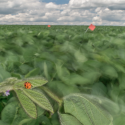Using DNA, scientists hunt for the roots of the modern potato
More than 99 percent of all modern potato varieties planted today are the direct descendents of varieties that once grew in the lowlands of south-central Chile. How Chilean germplasm came to dominate the modern potato-which spread worldwide from Europe-has been the subject of a long, contentious debate among scientists.
While some plant scientists have maintained that Chilean potatoes were the first to be planted in Europe, a more widely accepted story holds that European potatoes were originally descended from plants grown high in the Andes mountains between eastern Venezuela and northern Argentina. According to this theory, Andean potatoes were wiped out during the Great Irish Potato Famine, the 19th-century late-blight epidemic that devastated potato fields across Europe, initiating the import of Chilean varieties to re-establish the crop.
“[The story of the potato] is one of the prominent stories in crop evolution books. Because of Mercedes [Ames’s] work, they’re going to have to rewrite the textbooks.”
David Spooner, professor of horticulture
In a report published today in the American Journal of Botany, UW–Madison researchers Mercedes Ames and David Spooner say both theories are wrong. By analyzing the DNA of historical potato specimens, the researchers found that both Chilean and Andean potatoes were grown in Europe decades before and decades after the famine, the first direct evidence that the potatoes were grown simultaneously in Europe.
"Basically, we found that the Andean potatoes got to Europe first, around 1700. However, Chilean potatoes were starting to get popular there 34 years before the late blight epidemic," says Ames, a graduate student in UW–Madison’s plant breeding and plant genetics program. The results also show that Andean potatoes grew as late as 1892 in Europe, proving they weren’t polished off by the late blight epidemic-and that they grew side by side with Chilean potatoes for many decades before the Chilean types became dominant.
To start the project, which was funded by the National Science Foundation, Ames visited herbaria throughout Europe in search of early potato specimens. She requested hole-punch sized samples of dried leaf tissue from appropriate specimens be sent to Madison for study, eventually ending up with material from 64 potato plants grown between 1700 and 1910.
"Some of these samples were over 300 years old and not ideally preserved," says Spooner, a professor of horticulture and USDA researcher who is the paper’s corresponding author. "It took considerable innovation for Mercedes to work out the correct technique to get DNA from them."
After successfully extracting DNA from 49 samples, Ames analyzed each using a DNA marker that distinguishes between upland Andean and lowland Chilean potato types. The result is a biochemical record of ancestry, which Spooner says adds hard evidence to a debate often premised on guesswork.
"The problem with these two theories is that they rely on inferences based on the morphology of old plant samples, as well as inferences based on historical records about day-length adaptation, shipping routes, and the role of the late blight epidemic," he says. "Our work is the first direct evidence — as opposed to the inferential evidence used in prior studies — on the origin of the European potato because the herbarium specimens we used are like fossils."
Spooner notes that this type of analysis could help set the record straight for many other crop species. "Potato is one of the prominent stories in crop evolution books," says Spooner. "Because of Mercedes’s work, they’re going to have to rewrite the textbooks."
Tags: agriculture, horticulture, research

